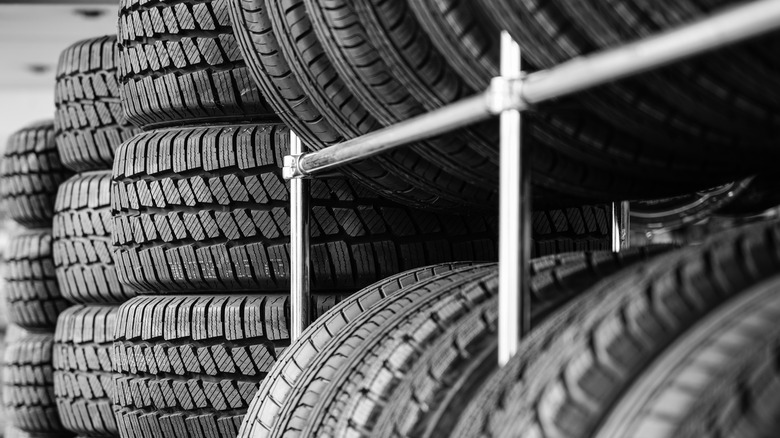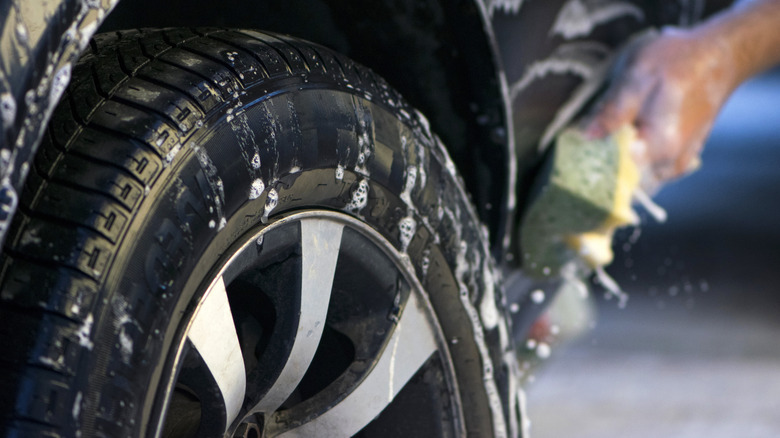Why Do New Tires Have A White Residue? (And How To Get Rid Of It)
Tires play a crucial role in keeping us safe on the road. These rubber components bear the responsibility of carrying the vehicle's weight and transmitting braking and traction forces to the road surface. However, although they are designed to last a significant amount of time, tires have an expiration date (on average, three to five years, depending on your driving habits and conditions). And when they get too old or display signs of damage, like uneven wear or bulging of the sidewall, it might be time to get a new set.
When you purchase a new tire, you expect it to have a natural black finish. But sometimes you might see something unexpected, like a white film covering the rubber surface. At a glance, it might look like dried soap or wax, and might even raise some concerns about the tire's condition. But you don't have to worry. That white residue on tires is a byproduct of the curing process, and it's totally harmless (although it will affect the look of your tires). In fact, this waxy film can sometimes act as a shield that protects your tires from premature cracking.
White residue on new tires is not a defect but a normal byproduct of tire manufacturing
Tire manufacturers usually use heavy-duty molds to make quality tires. And to eject the tires from the mold cavity safely without damaging the rubber, they typically use a release agent. Without it, the freshly made rubber could deform or tear when removed, affecting the tire's shape. And while this agent works like a lubricating oil that makes it easier for tires to get out of the mold, it also leaves a white coating on the tire's surface that resembles a cloudy gaze or a waxy film.
Another reason new tires might have a white residue is because of additives. Tires (both old and new) can deteriorate because of several factors, such as exposure to UV rays, heat, ozone, and even infrequent use. So, to extend the lifespan of new tires, manufacturers usually apply storage preservatives to the rubber. These additives typically create a thin protective layer that shields the rubber against harsh elements. In addition, the additives usually cling to the tire's surface, creating a chalky coating that compromises the look of the tire.
How to wash away the white residue from new tires
Despite the benefit this white residue might offer, it's a good idea to wash it off before you hit the road. After all, jet black tires can add to the looks of your car, and tires with a chalky appearance can ruin that look. Even worse, they can make your vehicle look poorly maintained. Luckily, if you plan to clean your tires, the process is simple. But you must use the right products to protect the rubber from degrading.
To begin your cleaning, you'll need to purchase a degreaser or an all-purpose cleaner like WD-40. It's best that you avoid harsh cleaners like acetone or bleach. While these products might effectively give your tires a black finish, repeated use will dry out and damage the rubber surface. Now, spray your cleaner directly onto the wheel and let it sit for a few minutes. From there, use a dry microfiber cloth to agitate the cleaner and repeat the process in case of stubborn residue.
A word of caution: don't use harsh brushes to scrub off the white residue. As tempting as it might be, these brushes will scratch and damage the rubber, potentially leading to premature wear. And while it is not mandatory, it's a good idea to apply a layer of tire shine to your wheels after washing away the white residue. Not only will this product give your wheels a rich, black finish, but it will also shield your tires from harsh elements like UV rays.


